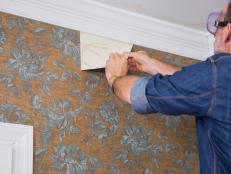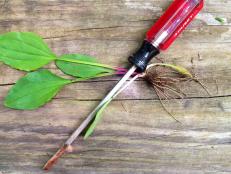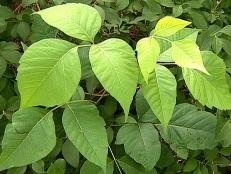How to Remove Wallpaper Using Solvents or Steam

Tools and Materials:
wallpaper solvent
dropcloth or plastic sheeting
tri-sodium phosphate (TSP)
spackling compound
sandpaper
perforating tool
wallpaper steamer
scraping tools (wallpaper scraper, drywall or putty knife)
rubber gloves and eye protection
Step 1: Prep the Room

Remove all electrical face plates, telephone jacks, picture hangers and any other obstructions on the walls. Cover the outlets and switches with tape to protect them from liquids.
Use a water-resistant drop cloth or plastic sheeting to protect the carpet or floors.
Watch a video of this step:
Step 2: Test the Old Wallpaper’s Adhesion
Some wallpapers, particularly the foil and water-resistant types, are strong and made with glues that easily release when they are pulled away from the wall. Before you begin the more difficult processes described below, start at a corner or seam and try peeling the wallpaper away from the surface. If it releases without tearing the underlying drywall paper or leaving swaths of backing behind, you may not have to steam or use a solvent. And even if remnants cling to the walls, after most of the paper is pulled down, you may be able to simply scrape them off without resorting to more drastic removal measures.
Watch a video of this step:
Step 3: Perforate the Old Wallpaper

Whether you opt to use the solvent or steaming removal method, first use a wallpaper-perforating tool such as a "paper tiger," which has rollers with small spikes that punch tiny holes in the paper.

This allows the solvent to penetrate behind the paper and dissolve the adhesive. If the surface is drywall, don’t press too hard on the tool or you’ll penetrate the drywall’s paper surface. If this happens, you'll need to fill the nicks with spackling compound before painting or applying new wallpaper.
Watch a video of this step:
Step 4: The Solvent Method
Most solvents are caustic, so if you choose this method wear rubber gloves and eye protection. Commercial solvents are usually mixed with water or available as a gel that is used without mixing. Follow the product directions and apply it with a paintbrush or sponge, then allow the solvent time to soak in and loosen the wallpaper. You’ll know the solvent is working when the paper begins to sag or pull away from the wall.
Inexpensive solvent alternatives include mixing hot water with a few tablespoons of white vinegar, or hot water and fabric softener, both of which can be applied with a spray bottle. Mix small batches at a time to keep the water as hot as possible. Saturate the wallpaper in sections, spraying only as much of the wall as you can comfortably strip in a 15-minute period.
Watch a video of this step:
Step 5: The Steam Method
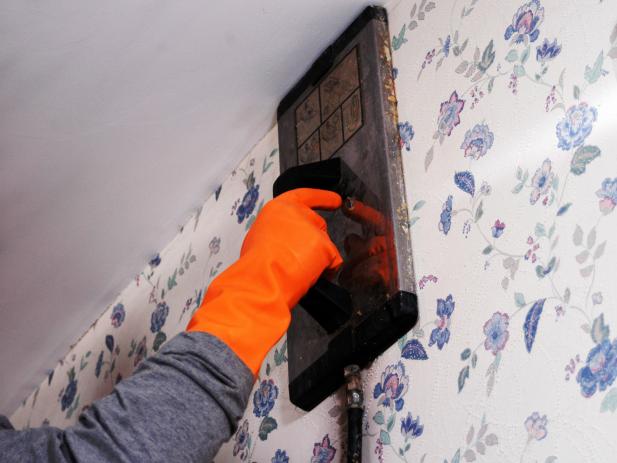
You can rent a commercial wallpaper steamer as an alternative to solvents. Steamers are especially good at removing stiff, heavy, old-style wallpapers and papers that have been adhered for a very long time.
Like solvents, steamers are messy in their own way, releasing hot steam and dripping hot water, so wear work gloves or rubber gloves and eye protection with this method as well. Steamers also introduce copious amounts of moisture into a room, so open a window or ventilate with fans to prevent moisture buildup in confined areas.
To use a wallpaper steamer, place the steamer pad on the surface of the wallpaper and hold it long enough to allow the steam to penetrate the paper and soften the glue. Experience will tell you how long to hold the steamer pad against the wall — if you apply too little steam, the wallpaper will be difficult to remove. If you apply too much steam for too long, however, you can damage the drywall below and even soften a plaster surface.
Once the wallpaper is loosened, use a scraper to remove it — do not pull it away with your hands because the steam will have superheated the glue and paper and could cause burns. This process can be time-consuming, but the more effort you dedicate to steaming, the less time you'll spend scraping.
Step 6: Scrape Away the Wallpaper

After the solvent or steam has loosened the wallpaper, start removing the paper at a seam or edge of a perforation. Use a wallpaper scraping tool, plastic putty knife or drywall knife, being careful not to gouge or tear through the drywall paper of the wall surface below. You may have to keep applying steam or reapply solvent to stubborn areas. Continue scraping until all of the wallpaper and any backing is removed.
Watch a video of this step:
Step 7: Clean and Repair the Wall
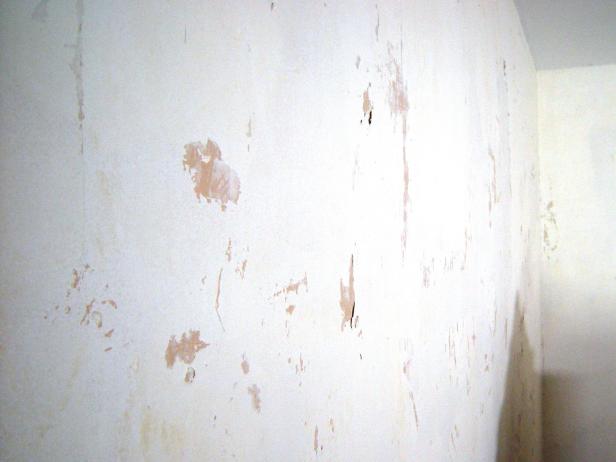
Prepare a bucket of very hot water mixed with a small amount of tri-sodium phosphate (TSP), a heavy-duty cleaner available at hardware stores. Use a sponge to wipe down the walls with this solution and remove all traces of wallpaper adhesive. Be careful not to oversaturate the walls. Finally, sponge the walls with clean water and towel dry.
Use spackling compound to patch any nicks or gouges in either drywall or plaster. Allow the repairs to dry thoroughly, then sand lightly with 150-grit sandpaper and wipe clean.
Watch a video of this step:








